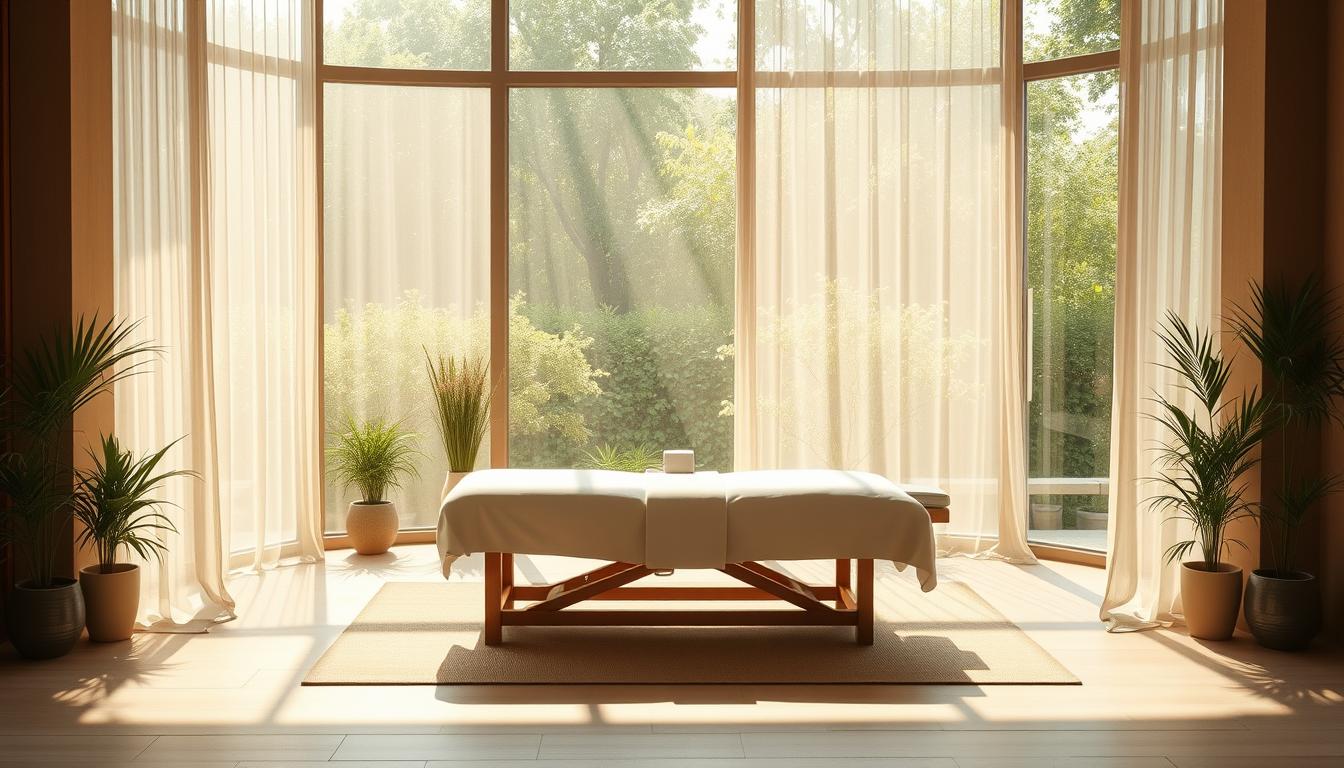Today, many people look for alternatives to drugs for their health. The rise of holistic wellness has made many seek safe, effective treatments. These treatments work with the body’s own healing ways.
Natural light therapy is a promising option for those wanting to improve their health without drugs. It uses your body’s natural responses to certain light wavelengths.
Phototherapy is now recognized by healthcare experts as a safe, easy treatment. Studies show it can help with mood disorders, sleep issues, and seasonal challenges.
This method goes back to basic wellness ideas that trust our bodies to heal. If you face winter blues, sleep problems, or mood issues, try phototherapy. It could be a key part of your wellness path.
What is Natural Light Therapy?
Light exposure therapy is a drug-free treatment that uses light to help your health. It’s not just about going outside on a sunny day. It involves specific light levels and timing to change your body’s natural processes.
Doctors often suggest this treatment because it works with your body, not against it. It helps your body’s natural rhythms by mimicking sunlight.
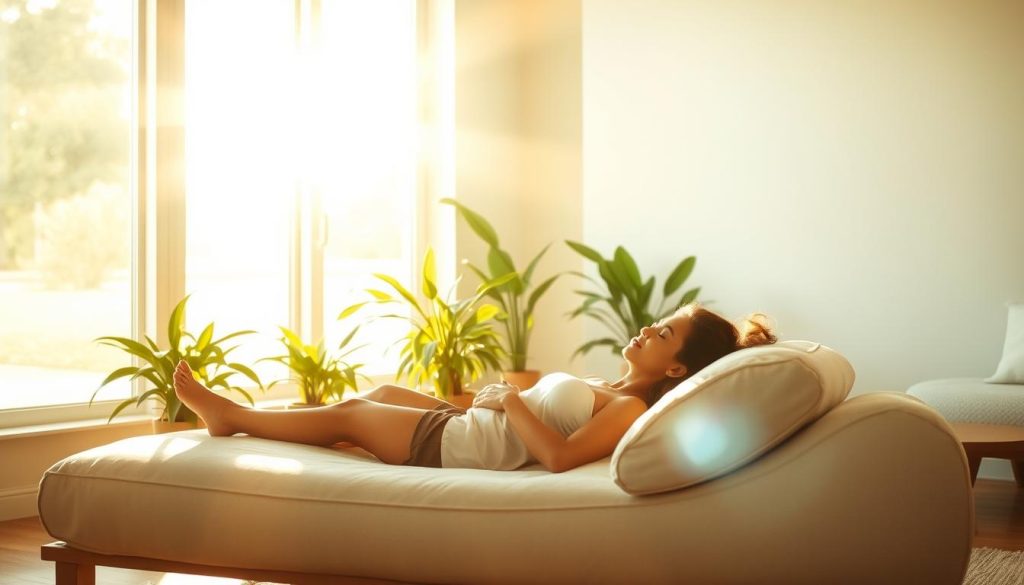
Understanding the Basics
Natural light therapy uses bright light to affect your body’s rhythms and hormone levels. You’ll be exposed to lights that are much brighter than regular indoor lights. But, it’s safe for treatment.
The therapy works by affecting special cells in your eyes. These cells send signals to your brain’s clock. This helps control your sleep, mood, and energy levels.
Today’s light therapy devices are advanced. They can give out different colors of light, like blue, white, or red. The timing of when you use the light is key to getting the best results.
Key Health Benefits
Light therapy has many benefits for your health. Many people feel happier and less anxious within a few days. It helps increase serotonin levels naturally.
It also improves sleep quality. If you have trouble sleeping, this therapy can help. It helps your body’s clock stay in sync with day and night.
Your energy levels will likely go up too. Morning light makes you feel more awake. Evening light helps you get ready for sleep.
It also helps with mood changes that come with the seasons. Many people find it helps with winter blues and depression. It’s a natural way to manage these mood swings without medication.
How Does Natural Light Therapy Work?
Natural light therapy affects your brain’s master clock and neurotransmitters. When light hits your eyes, it starts a chain of events. This affects your energy and mood.
Your body responds to light in specific ways. The timing and intensity of light signals control your body’s functions. Knowing this helps you use light therapy better in your daily life.
The Science Behind Light Therapy
Light therapy sends signals to your brain’s control center. When light hits special cells in your retina, it sends information to the suprachiasmatic nucleus. This tiny part of your brain controls your circadian rhythms.
The suprachiasmatic nucleus gets light signals and sets your internal clock. It controls hormone production, body temperature, and repair processes. Different light wavelengths have different effects.
Blue light is especially good for your circadian rhythms. Morning blue light exposure resets your internal clock. This keeps your body in sync with day and night.
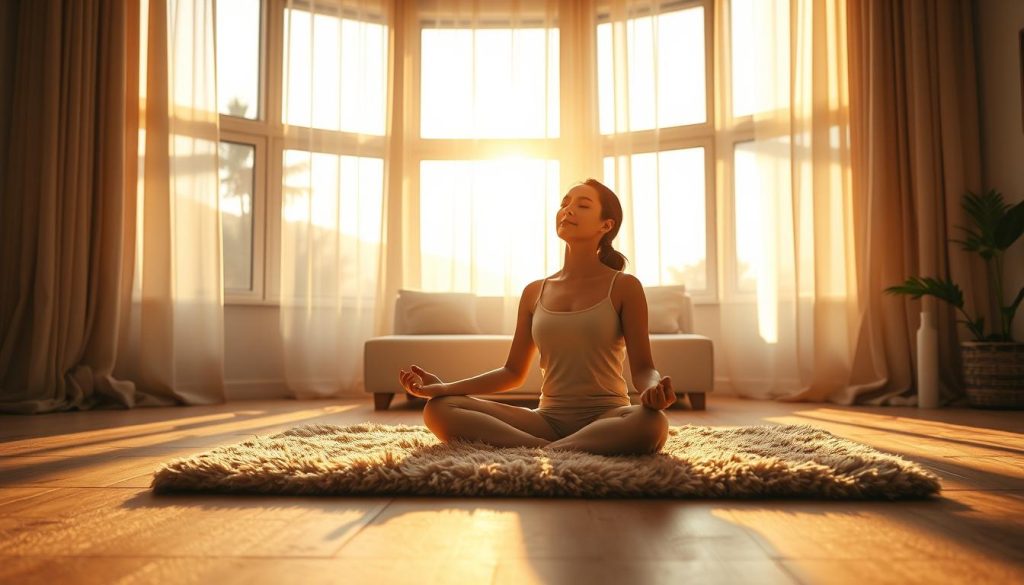
Your brain processes light information quickly. You can feel more alert and energized right away. But, the full benefits of light therapy take a few days of use.
The Role of Melatonin and Serotonin
Melatonin and serotonin are key neurotransmitters in light therapy. They help regulate your sleep-wake cycles and mood. Light exposure affects their production and timing.
Melatonin levels drop with bright light. This makes you feel more awake and alert. As it gets darker, melatonin levels go up to help you sleep.
Serotonin levels increase with light, especially in the morning. More serotonin means better mood and emotional balance. This is why natural light makes many people feel happier.
The timing of light therapy is important. Morning light helps set your sleep-wake cycles right. It also boosts serotonin levels all day.
Regular light therapy keeps melatonin and serotonin levels balanced. This leads to better sleep, mood, and energy. The more consistent you are, the better the results.
Benefits of Using Natural Light Therapy
Natural light therapy offers many health benefits that can change your life. It helps with both physical and mental health. People often see positive changes in just a few weeks.
Light therapy works by using your body’s natural systems. It helps your brain adjust hormone levels and your internal clock. This leads to many positive changes in your body.
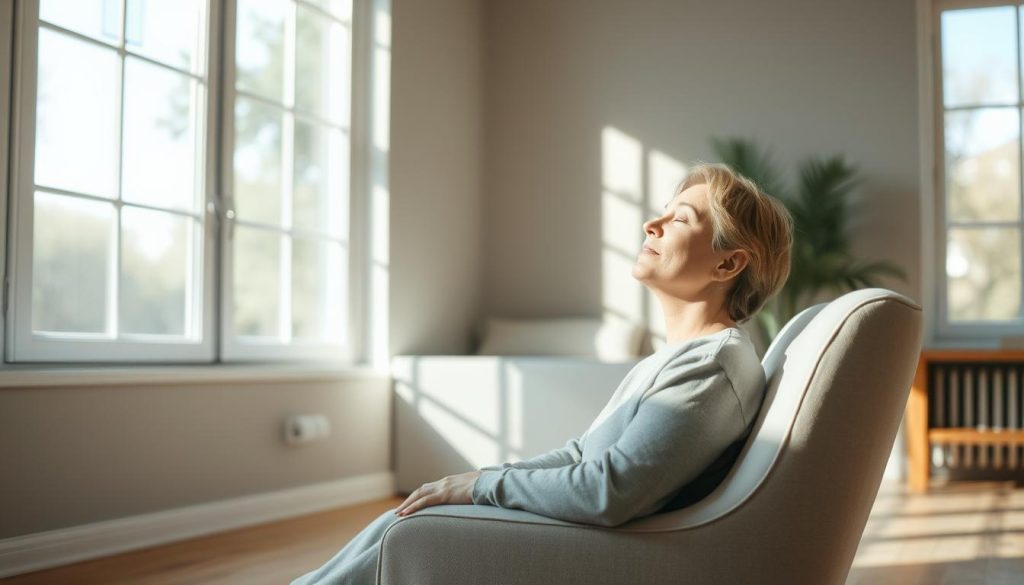
Improvement in Mood and Energy Levels
Light therapy can greatly improve your mood and energy. It helps keep your emotions stable. This makes it easier to stay positive all day.
Those with mood disorders often see big improvements. The therapy balances brain chemicals that affect your mood. Many feel more motivated and energetic after two weeks.
Your energy levels go up as your body’s rhythm gets better. Morning light tells your brain to make less melatonin. This makes you feel more awake and ready for the day.
- Reduced feelings of sadness and hopelessness
- Increased motivation for daily activities
- Better emotional stability throughout the day
- Enhanced focus and mental clarity
Enhanced Sleep Quality
Natural light therapy helps fix sleep problems. It helps you fall asleep and stay asleep. Your body learns to make sleep hormones at the right times.
Light in the morning helps your body’s clock. This makes it easier to sleep at night. You’ll wake up feeling refreshed every morning.
Sleep issues often get better in the first month. Your deep sleep gets longer and better. This helps your body and mind recover during sleep.
Support for Seasonal Affective Disorder (SAD)
Light therapy is a top treatment for SAD. This condition affects many in winter. It directly tackles winter depression.
People with SAD often see big improvements in two to four weeks. The therapy makes up for less sunlight in winter. This keeps your mood and energy stable all year.
Studies show light therapy works as well as medicine for SAD. It offers hope without the side effects of drugs. Regular use stops winter depression before it starts.
- Reduces winter depression symptoms by 60-80%
- Prevents seasonal mood changes before they start
- Maintains consistent energy levels during dark months
- Supports overall mental health stability
Different Types of Natural Light Therapy
Natural light therapy comes in many forms, from sunlight to special devices. Each has its own benefits and fits different lifestyles. Knowing these options helps you choose the best for your needs.
Sunlight Exposure
Sunlight is the best natural light therapy. It gives your body the full spectrum of light it needs. Morning sunlight, from 6 AM to 10 AM, is especially good for your body clock.
Spending 15 to 30 minutes in sunlight each day is ideal. This helps your body make vitamin D without too much UV. But, sunlight can be hard to get in winter or cloudy places.
In winter or cloudy areas, getting enough sunlight is tough. This is why other light therapy methods are important for staying healthy all year.
Light Therapy Boxes
Light therapy boxes give you intense, full-spectrum light like sunlight. They produce 10,000 lux, much brighter than regular indoor lights. This light helps your body respond like it would to real sunlight.
When picking light therapy lamps, look at light intensity, color, and safety. Make sure they block harmful UV rays. Place the light at eye level and use it at the same time every day.
Using these boxes for 20 to 30 minutes a day is best. You can do other things while using them, like reading or eating. Good ones have timers and brightness controls for you.
Specialized Lamps
Dawn simulation lamps are a new way to get natural light therapy. They slowly get brighter, like a sunrise, to wake you up. This helps your body clock more than alarm clocks.
There are lamps for different times and places. Desk lamps for work and bedside lamps for bedtime. These lamps can be set up to fit your schedule and preferences.
These lamps often have special features like nature sounds or aromatherapy. You can adjust the light and timing to suit your needs. This makes them great for a relaxing bedtime routine or a morning pick-me-up.
Finding the Right Natural Light Therapy for You
Finding the right natural light therapy means understanding your needs and lifestyle. Everyone reacts differently to light. It’s important to pick a method that suits you best.
Start by thinking about your health goals and daily life. Consider any health conditions that might affect your choices.
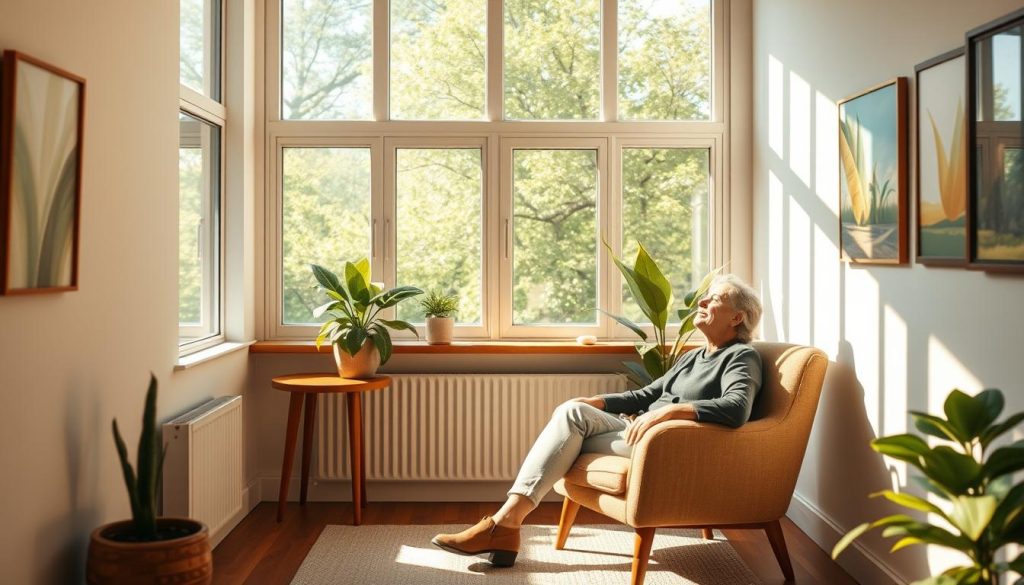
Consult a Healthcare Professional
Getting advice from a healthcare expert is key when starting light therapy. Doctors and specialists can help based on your health and history. They know how light affects different conditions.
It’s especially important if you’re on medication or have complex health issues. Some meds can make you more sensitive to light. Your doctor will figure out the best light levels and times for you.
Experts in mental health often use light therapy for mood and sleep issues. They can adjust your treatment to help you get the best results.
Consider Your Lifestyle and Preferences
Your daily life affects which light therapy works for you. Think about your work, home, and budget. Some like morning sunlight, while others prefer light therapy boxes.
Look at your living situation and space. If you can’t get outside often or live in a cloudy area, indoor devices might be better. Your budget also plays a part in what you choose.
What you prefer also matters. Some like outdoor activities, while others prefer indoor light therapy. Pick what feels right for you and your lifestyle.
The best light therapy is one you can keep up with. Choose what fits your personality, schedule, and lifestyle for lasting success.
How to Incorporate Natural Light Therapy into Your Routine
Adding natural light therapy to your daily life can change your wellness journey. It’s about setting up routines that fit your natural flow and daily tasks. By timing your light exposure right, you boost energy, focus, and sleep quality without changing your routine too much.
Creating a good light therapy schedule means focusing on three main times. Morning sets you up for the day. Midday keeps you going and fights off tiredness. Evening helps you relax and get ready for sleep.
Morning Sunlight for Energy
Getting natural light early in the morning helps wake you up and gives you energy. Just 15-20 minutes of sunlight can make a big difference in how you feel all day. It’s about being consistent, not how long you’re in the sun.
Here are some easy ways to get more morning light:
- Open curtains and blinds as soon as you wake up
- Drink your morning coffee or tea by a sunny window
- Take a short walk outside during breakfast
- Do your morning workout or stretching in a bright spot
- Use a light therapy box if you can’t get outside
Even artificial bright light can help if you can’t get natural sunlight. It tells your body it’s time to be awake and alert.
Midday Breaks for Productivity
Light exposure in the middle of the day helps fight off the usual afternoon slump. Short breaks in bright spots can refresh your mind and keep you productive all day.
Here are some tips for office workers:
- Take a 10-15 minute walk outside during lunch
- Eat lunch by a window with natural light
- Have walking meetings outdoors when you can
- Put your desk near the brightest light source
- Use a desk lamp with full-spectrum bulbs in darker months
Remote workers and those with non-traditional hours can also use these tips. Just make sure to take breaks or use bright lights during your most active times.
Evening Wind-down with Dim Lighting
It’s just as important to reduce light in the evening as it is to increase it during the day. Dim lighting before bed helps your body make melatonin and get ready for sleep.
Make your evening routine by slowly dimming the lights as bedtime gets closer. Use warm, dim lights at least two hours before bed. Avoid bright screens or use blue light filters on devices.
Simple evening habits include using table lamps instead of overhead lights, lighting candles during dinner, and keeping bedroom lighting low. These small changes help keep your sleep-wake cycle natural and improve sleep quality.
Safety and Precautions
Natural light therapy is safe if you follow basic steps to protect your skin and eyes. Most people can use bright light treatment safely by taking simple precautions. These steps help you get the best results without problems.
Knowing how to stay safe makes light therapy effective and stress-free. The goal is to balance the benefits with smart protection.
Protecting Your Skin
Your skin needs protection when you’re in natural sunlight, especially with bright light treatment. Start with short sessions of 10-15 minutes and increase the time as your skin gets used to it. This prevents sunburn and helps you build up safely.
Use broad-spectrum sunscreen with at least SPF 30 when you’re outside for light therapy. Apply it to exposed areas like your face, neck, and hands. Reapply every two hours if you’re outside for a long time.
Choose the right time for outdoor sessions. Early morning sunlight between 7-9 AM is great for therapy and has lower UV intensity. Avoid peak sun hours from 10 AM to 4 PM when UV rays are strongest and can damage your skin.
Watch for signs of overexposure like redness, warmth, or tingling. If you see these signs, move to shade right away and shorten your exposure time for future sessions. Your skin should feel comfortable during and after treatment.
Eye Safety Considerations
Protecting your eyes during bright light treatment is key for healthy vision. Never look directly at the sun or bright therapy lights. Instead, let the light reach your eyes indirectly through your peripheral vision while focusing on other activities.
Position light therapy boxes at the correct distance and angle. Most devices should be placed 16-24 inches away from your face at a slight downward angle. This positioning provides benefits without straining your eyes or causing discomfort.
Start with shorter sessions of 15-20 minutes when using artificial light devices. Gradually increase the duration as your eyes adjust to the brightness. If you experience headaches, eye strain, or excessive tearing, reduce the session length or take breaks.
People with certain eye conditions should talk to their eye doctor before starting light therapy. This includes individuals with glaucoma, cataracts, or retinal disorders. Your eye care professional can give you personalized guidance for safe treatment.
Stop treatment immediately if you experience persistent eye pain, vision changes, or severe headaches. These symptoms may mean the light intensity is too strong or the exposure time is too long for you.
Research and Studies on Natural Light Therapy
Scientific research keeps showing how well natural light therapy works for many health issues. Studies from top medical places show clear benefits when light therapy is used in treatment plans.
Recent Findings in Clinical Studies
A 2023 study in the Journal of Affective Disorders found big mood boosts in 70% of people after two weeks of light therapy. Harvard Medical School found that phototherapy can fix circadian rhythms in just five days of morning light.
People using light therapy boxes sleep 60% better than others. The American Academy of Sleep Medicine now sees light therapy as a top treatment for sleep issues.
Long-term Benefits and Risks
Studies lasting three years show long-term benefits of light therapy. Users keep feeling more energetic and stable in mood without getting used to it. The research shows very few risks if safety rules are followed.
New studies are looking into using light therapy for brain health and boosting the immune system. This growing evidence makes natural light therapy a safe and effective way to stay well, supported by science.

